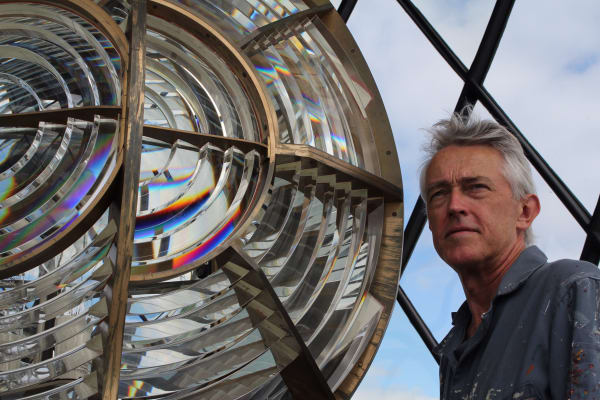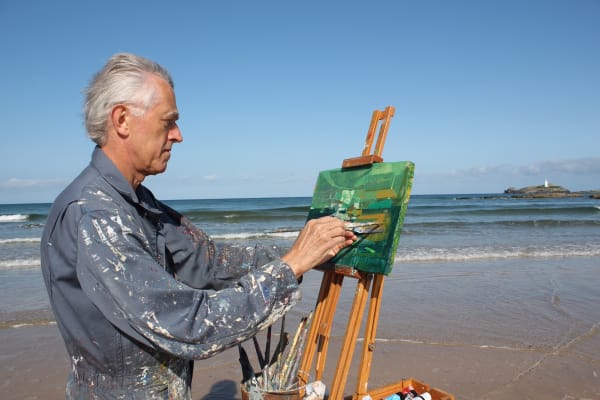Jeremy Gardiner - Pillars of Light
This exhibition of thirty paintings is centred around the theme of the lighthouse. Jeremy Gardiner has travelled around the south-west coast, painting sixteen lighthouses and their surroundings in three counties, Cornwall, Devon and Dorset, including three islands, the Isle of Wight, Lundy Island and Godrevy Island. The work you see here results from many hours spent on the coast, making meticulous line drawings, studying weather conditions at first hand and painting en plein air. This is followed by many further hours in the studio, recollecting the moods and emotions felt in each place, translating them into colours, textures and shapes, layering and excavating the surface of each panel, shifting the elements in the composition until the result satisfies the eye. Jeremy has studied the histories of each lighthouse and spent time inside them, talking to their custodians, examining the optics and engineering. His approach to the landscapes in which they stand is underpinned by a strong sense of what lies beneath. He is interested in the rocks and the mineshafts that lie physically beneath the surface, but also their history in deep time: the processes of erosion and upheaval that have shaped the coast as we see it today. He describes his work in the studio as "trying to locate a memory"; and just as his paintings are layered, so too are his memories, going back to his childhood on the Dorset coast and his first experience of the lighthouse at Anvil point. Personal, cultural and geological memories come together in these evocative paintings.
Lighthouses are powerful symbols. A warning or welcoming light in the dark, a strong tower by day, they signify the collective effort of a community to offer help to those out on the sea. The lighthouses around the British coast, run by the Corporation of Trinity House, have been vital navigational aids to seamen over many centuries. Their history in these islands goes right back to the first century, when two lighthouses were built at Dover Castle soon after the Roman invasion of Britain in 43 AD. Lighthouses have been seen as metaphors for the conquest of darkness by light, and thus for the role of religious faith in enabling the human soul to negotiate the rocks and storms of the earthly life. In modern times, the distinctive codes of their lights were developed as a result of international cooperation, as an awareness of the needs of humanity in general took precedence over narrow nationalistic sentiments. As the French writer Jules Michelet put it in his classic work, La Mer, published in 1861, "Si le vent, la mer, sont contre, tu n'est pas seul, l'Humanité est là qui vieille pour toi."
British lighthouses have been fully automated since 1998. In several cases, the cottages that once provided accommodation for stoical lighthouse keepers and their families have been converted into holiday homes, much sought after for the wonderful views, walks and birdwatching opportunities they provide. Lighthouses no longer play such a crucial role in preventing shipwrecks, but they continue to be much loved. In 2010 an Aids to Navigation Review, conducted by Trinity House, concluded that lighthouses were a complementary but secondary system to Global Navigation Satellite Systems such as GPS. However, the resulting proposal that some of them, including Godrevy and Hartland Point, could be closed aroused such strong opposition that a compromise had to be reached, and these two lighthouses continue to cast their beams (albeit of reduced strength) into the darkness of the Bristol Channel and the Atlantic Ocean. The Godrevy and Hartland Point lighthouses appear in four paintings in this exhibition.
The lighthouses painted by Jeremy Gardiner occupy, in nearly every case, dramatic positions on rocky coasts, exposed cliffs or islands. Lynmouth Foreland, for example, was built half way up steep cliffs, to which it seems to cling precariously; the lighthouse at Start Point is on one of the most exposed headlands in Britain, jutting out a full mile into the English Channel. Their histories are evidence of a constant battle against the eroding power of the sea. The Bull Point lighthouse had to be rebuilt after fifty feet of the cliff face crashed into the sea in 1972; the lighthouse at Hartland Point was strengthened by a sea wall in 1925, near the jagged rocks which once surrounded a harbour, which itself was swept away by the sea in 1887. The sites of these buildings are places with a great sense of space and wind, constantly varying cloudscapes and ever-changing colours in the landscape. While such places offer great challenges to the artist - not least in finding a safe place from which to study them - they also offer great possibilities. The lighthouses themselves are extremely useful compositional devices. A vertical accent against a predominantly horizontal landscape, a flash of white against the darker land, sea and sky, a mathematically regular, precise form against the amorphous qualities of rocks and hills. Even when they are tiny forms, seen from a great distance, they pull a landscape together, gathering up the lines of perspective and structure in a single point of focus. Many
artists have painted lighthouses, but few have been so successful as Jeremy Gardiner in communicating a sense of the uncompromising landscapes within which many of them sit.
(text from catalogue introduction by Christiana Payne 2016)



